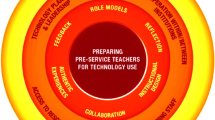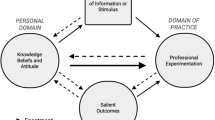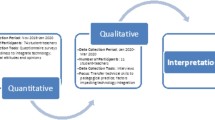Abstract
Pre-service training is the most important stage when teachers learn about integrating technology into their teaching. Pre-service teachers’ perceptions of the effectiveness of technologies can be used to predict their intention of including technology in their classrooms in the future. Having the necessary technical equipment available is considered important by these teachers to deal with current educational problems, and find solutions. Therefore, pre-service teachers’ educational activities were studied in this study and the use of new technologies in education was discussed. The contribution of different methods regarding the use of digital technologies for instructional purposes by pre-service teachers in different departments was investigated. The purpose of this study was to determine whether the different methods have an effect on the teachers’ technology integration self-efficacy (TISE), motivation, satisfaction and attitude towards the use of technology. The opinions of the pre-service teachers about the technologies used in the lessons were also analyzed. This study employed a mixed-method methodology. The sample in this study comprised 96 pre-service teachers at a university in Turkey who were divided into groups. The study involved a personal information form, semi-structured interview form, and four different scales. An ANCOVA analysis and descriptive statistics were used with the quantitative data, and content analysis was used in the analysis of the qualitative data. The results of this research show that a significant difference exists between the technology integration exercises performed using different methods, the students’ level of contribution to TISE and their motivation and technology use attitudes (TUA). The motivation and satisfaction levels were higher in the groups where authentic task-based instruction was used. It has been observed that closed-ended practical tasks support students’ self-efficacy to integrate technology. On the other hand, open-ended task-based activities were found to support an increase in attitudes towards technology use more than in the other groups. The group where closed-ended applications for technology integration self-efficacy, motivation, satisfaction and use of technology were performed differed in terms of gender, department and grade.

Similar content being viewed by others
Explore related subjects
Discover the latest articles, news and stories from top researchers in related subjects.References
Agyei, D. D., & Voogt, J. M. (2011). Exploring the potential of the will, skill, tool model in Ghana: Predicting prospective and practicisng teachers’ use of technology. Computers & Education, 56(1), 91–100.
Bakaç, E., & Özen, R. (2018). The relationship between preservice teachers’ self-directed learning readiness levels and technological pedagogical content knowledge (TPACK) competencies. Education in Science, 13(2), 90–105.
Bandura, A. (1977). Self-efficacy: Toward a unifying theory of behavioral change. Psychological Review, 84(2), 191–215.
Beckers, J., Dolmans, D., & Van Merriënboer, J. (2016). E-portfolios enhancing students’ self-directed learning: A systematic review of influencing factors. Australasian Journal of Educational Technology, 32(2), 32–46.
Bibi, S., & Khan, S. H. (2017). TPACK in action: A study of a teacher educator’s thoughts when planning to use ICT. Australasian Journal of Educational Technology, 33(4), 70–87.
Blikstein, P. (2011). Using learning analytics to assess students’ behavior in open-ended programming tasks. In Proceedings of the 1st international conference on learning analytics and knowledge (pp. 110-116).
Bryman, A. (2016). Social research methods (5th ed.). Oxford University Press.
Büyüköztürk, S., Akgün, Ö. E., Özkahveci, Ö., & Demirel, F. (2004). The validity and reliability study of the Turkish version of the motivated strategies for learning questionnaire. Educational Sciences: Theory & Practice, 4(2), 231–239.
Chai, C. S., Koh, J. H. L., Tsai, C. C., & Tan, L. L. W. (2011). Modeling primary school pre-service teachers’ technological pedagogical content knowledge (TPACK) for meaningful learning with information and communication technology (ICT). Computers & Education, 57(1), 1184–1193.
Chambers, D. (2001). Problem-Based Learning & It To Support Authentic Tasks In Teacher Education. In Meeting at the crossroads, short paper proceedings of the 18th Annual Conference of the Australian Society for Computers in Learning in Tertiary Education (pp. 25–8).
Creswell, J. (2012). Educational research: Planning, conducting, and evaluating quantitative and qualitative research (4th ed.). Pearson.
Crompton, H., Burke, D., & Gregory, K. H. (2017). The use of mobile learning in PK-12 education: A systematic review. Computers & Education, 110, 51–63.
Demirtaş, B. (2020). The effect of ICT course given by distance education method on the preservice teachers’ ICT competencies and technological pedagogical content knowledge. Unpublished master thesis, Manisa Celal Bayar Üniversitesi.
Drent, M., & Meelissen, M. (2008). Which factors obstruct or stimulate teacher educators to use ICT innovatively? Computers & Education, 51(1), 187–199.
Durak, H. Y., & Saritepeci, M. (2017). Investigating the effect of technology use in education on classroom management within the scope of the FATİH project. Çukurova Üniversitesi Eğitim Fakültesi Dergisi, 46(2), 441–457.
Durak, H., Sarıtepeci, M., & Durak, A. (2016). Farklı Branşlardaki Öğretmenlerin Eğitimde Teknoloji Kullanım Durumlarıyla İlgili Görüşleri. World Congress on Lifelong Education, WCLE- 2016, 16–17 December 2016. Porto Bello Hotel Resort& SPA.
Durak, H. Y., Sarıtepeci, M., & Çam, F. B. (2020). Arkeoloji Alanında Artırılmış Gerçeklik Teknolojisinin Kullanımına Yönelik Üniversite Öğrencilerinin Görüşlerinin İncelenmesi. Eğitimde Nitel Araştırmalar Dergisi, 8(1), 156–179.
Ertmer, P. A., Ottenbreit-Leftwich, A. T., Sadik, O., Sendurur, E., & Sendurur, P. (2012). Teacher beliefs and technology integration practices: A critical relationship. Computers & Education, 59(2), 423–435.
Eryılmaz, M. (2012). The effect of hyper media on academic achievement satisfaction and cognitive load of students by using adaptive presentation and adaptive navigation. (PhD thesis). Ankara University.
Firat, E. A., & Köksal, M. S. (2019). Effects of instruction supported by web 2.0 tools on prospective teachers’ biotechnology literacy. Computers & Education, 135, 61–74.
Günbatar, M. S. (2014). Bilgi ve İletişim Teknolojilerine Yönelik Bir Tutum Ölçeği Geliştirme Çalışması. Journal of Kirsehir Education Faculty, 15(1), 121–135.
International Society for Technology in Education [ISTE]. (2018). ISTE standards. Retrieved from https://www.iste.org/standards/for-educators.
Iriti, J., Bickel, W., Schunn, C., & Stein, M. K. (2016). Maximizing research and development resources: Identifying and testing “load-bearing conditions” for educational technology innovations. Educational Technology Research and Development, 64(2), 245–262.
Kabakci Yurdakul, I., & Çoklar, A. N. (2014). Modeling preservice teachers’ TPACK competencies based on ICT usage. Journal of Computer Assisted Learning, 30(4), 363–376.
Kale, U. (2018). Technology valued? Observation and review activities to enhance future teachers’ utility value toward technology integration. Computers & Education, 117, 160–174.
Karataş, F. İ. (2014). An examination of in-service secondary mathematics teachers’ technological pedagogical content knowledge and their technology integration self-efficacy. Master thesis, Boğaziçi University.
Kordaki, M., & Gousiou, A. (2017). Digital card games in education: A ten year systematic review. Computers & Education, 109, 122–161.
Koutromanos, G., Styliaras, G., & Christodoulou, S. (2015). Student and in-service teachers’ acceptance of spatial hypermedia in their teaching: The case of HyperSea. Education and Information Technologies, 20(3), 559–578.
Kula, A. (2016). Subject culture in the process of information and communication technology integration in education. Unpublished doctorate thesis, Ankara Üniversitesi.
Lowrie, T. (2002). Designing a framework for problem posing: Young children generating open-ended tasks. Contemporary Issues in Early Childhood, 3(3), 354–364.
McGrath, J., Karabas, G., & Willis, J. (2011). From TPACK concept to TPACK practice: An analysis of the suitability and usefulness of the concept as a guide in the real world of teacher development. International Journal of Technology in Teaching & Learning, 7(1), 1–23.
Nelson, J., Christopher, A., & Mims, C. (2009). Transformation of teaching and learning. TechTrends, 53(5), 81–87.
Nyambane, C. O., & Nzuki, D. (2014). Factors influencing ICT integration in teaching-a literature review. International Journal of Educational Research, 2(3), 1–17.
Orhan, D., Kurt, A. A., Ozan, Ş., Vural, S., & Turkan, F. (2014). A holistic view to national educational technology standards. Karaelmas Journal of Educational Sciences, 2, 65–79.
Osana, H. P., Lacroix, G. L., Tucker, B. J., & Desrosiers, C. (2006). The role of content knowledge and problem features on preservice teachers’ appraisal of elementary mathematics tasks. Journal of Mathematics Teacher Education, 9(4), 347–380.
Ottenbreit-Leftwich, A. T., Glazewski, K. D., Newby, T. J., & Ertmer, P. A. (2010). Teacher value beliefs associated with using technology: Addressing professional and student needs. Computers & Education, 55(3), 1321–1335.
Pintrich, P. R., Smith, D. A., García, T., & McKeachie, W. J. (1991). A manual for the use of the motivational strategies for learning questionnaire (MSLQ). University of Michigan, National Center for Research to Improve Postsecondary Teaching and Learning.
Ryan, R. M., & Deci, E. L. (2000). Intrinsic and extrinsic motivations: Classic definitions and new directions. Contemporary Educational Psychology, 25(1), 54–67.
Şad, S. N., & Nalçacı, Ö. İ. (2015). Prospective teachers’ perceived competencies about integrating information and communication technologies into education. Mersin University Journal of the Faculty of Education, 11(1), 177–197.
Sang, G., Valcke, M., Van Braak, J., & Tondeur, J. (2010). Student teachers’ thinking processes and ICT integration: Predictors of prospective teaching behaviors with educational technology. Computers & Education, 54(1), 103–112.
Saritepeci, M., Duran, A., & Ermiş, U. F. (2019). A new trend in preparing for foreign language exam (YDS) in Turkey: Case of WhatsApp in mobile learning. Education and Information Technologies, 24(5), 2677–2699.
Schwichow, M., Zimmerman, C., Croker, S., & Härtig, H. (2016). What students learn from hands-on activities. Journal of Research in Science Teaching, 53(7), 980–1002.
Swallow, M. J., & Olofson, M. W. (2017). Contextual understandings in the TPACK framework. Journal of Research on Technology in Education, 49(3–4), 228–244.
Tondeur, J., van Braak, J., Sang, G., Voogt, J., Fisser, P., & Ottenbreit-Leftwich, A. (2012). Preparing pre-service teachers to integrate technology in education: A synthesis of qualitative evidence. Computers & Education, 59(1), 134–144.
Tseng, J. J., Cheng, Y. S., & Yeh, H. N. (2019). How pre-service English teachers enact TPACK in the context of web-conferencing teaching: A design thinking approach. Computers & Education, 128, 171–182.
Ünal, E. (2013). Öğretmen adaylarının teknoloji entegrasyonu öz-yeterlik algıları ve teknolojik pedagojik içerik bilgisi yeterlikleri arasındaki ilişkinin incelenmesi. Unpublished doctorate thesis, Ankara Üniversitesi.
Viseu, F., & Oliveira, I. B. (2017). Open-ended tasks in the promotion of classroom communication in mathematics. International Electronic Journal of Elementary Education, 4(2), 287–300.
Yildiz Durak, H. (2017). Turkish adaptation of the flipped learning readiness scale for middle school students. Bartin University Journal of Faculty of Education, 6(3), 1056–1068.
Yildiz Durak, H. (2018). Flipped learning readiness in teaching programming in middle schools: Modelling its relation to various variables. Journal of Computer Assisted Learning, 34(6), 939–959.
Yildiz Durak, H. (2019a). Examining the acceptance and use of online social networks by preservice teachers within the context of unified theory of acceptance and use of technology model. Journal of Computing in Higher Education, 31(1), 173–209.
Yildiz Durak, H. (2019b). Modeling of relations between K-12 teachers’ TPACK levels and their technology integration self-efficacy, technology literacy levels, attitudes toward technology and usage objectives of social networks. Interactive Learning Environments, 1–27.
Zaslavsky, O. (1995). Open-ended tasks as a trigger for mathematics teachers’ professional development. For the Learning of Mathematics, 15(3), 15–20.
Zimmerman, B. J., & Bandura, A. (1994). Impact of self-regulatory influences on writing course attainment. American Educational Research Journal, 31(4), 845–862.
Author information
Authors and Affiliations
Corresponding author
Additional information
Publisher’s note
Springer Nature remains neutral with regard to jurisdictional claims in published maps and institutional affiliations.
Rights and permissions
About this article
Cite this article
Yildiz Durak, H. Preparing pre-service teachers to integrate teaching technologies into their classrooms: Examining the effects of teaching environments based on open-ended, hands-on and authentic tasks. Educ Inf Technol 26, 5365–5387 (2021). https://doi.org/10.1007/s10639-021-10511-5
Received:
Accepted:
Published:
Issue Date:
DOI: https://doi.org/10.1007/s10639-021-10511-5




